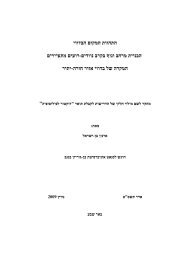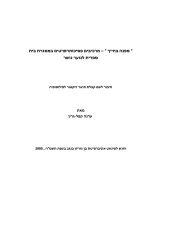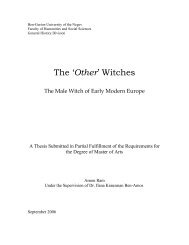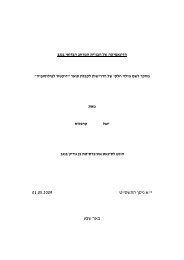Ben-Gurion University of the Negev Jacob Blaustein Institutes for ...
Ben-Gurion University of the Negev Jacob Blaustein Institutes for ...
Ben-Gurion University of the Negev Jacob Blaustein Institutes for ...
Create successful ePaper yourself
Turn your PDF publications into a flip-book with our unique Google optimized e-Paper software.
22<br />
more sophisticated model that allows a better description <strong>of</strong> real life situation: <strong>the</strong><br />
transshipment model.<br />
Though, <strong>the</strong> transportation model is not realistic <strong>for</strong> <strong>the</strong> following reasons:<br />
1. <strong>the</strong> network is designed with no consideration <strong>for</strong> <strong>the</strong> geomorphologic<br />
aspect <strong>of</strong> <strong>the</strong> study area. There<strong>for</strong>e, <strong>the</strong> arcs <strong>of</strong> connection that were<br />
sketched in <strong>the</strong> model may be completely unfeasible in a real life<br />
situation;<br />
2. each source is directly connected to each and every destination with a<br />
dedicated arc.<br />
3. destinations are not connected between each o<strong>the</strong>r.<br />
These may be <strong>the</strong> reasons <strong>of</strong> very probable unwanted redundancies <strong>of</strong> arcs resulting in<br />
<strong>the</strong> calculation <strong>of</strong> unpractical solutions. There<strong>for</strong>e <strong>the</strong> transportation model does not<br />
provide realistic solutions <strong>for</strong> this study in terms <strong>of</strong> any practical field application. The<br />
transportation model is used as a stepping stone <strong>for</strong> <strong>the</strong> transshipment model<br />
3.3 The Transshipment Model<br />
The standard transportation model assumes that <strong>the</strong> direct route between a source and a<br />
destination is <strong>the</strong> only possible connection between supply and demand <strong>of</strong> water.<br />
An alternative procedure to <strong>the</strong> use <strong>of</strong> regular transportation model is <strong>the</strong> so called<br />
transshipment model. This model has <strong>the</strong> additional feature <strong>of</strong> considering <strong>the</strong><br />
transportation from sources to destination to be allowed to pass through intermediate<br />
nodes be<strong>for</strong>e ultimately reaching <strong>the</strong>ir designated destination.<br />
An example will be used to describe <strong>the</strong> ma<strong>the</strong>matical method applied <strong>for</strong> <strong>the</strong> solution<br />
<strong>of</strong> <strong>the</strong> problem. Figure 8 represents a lay-out <strong>of</strong> a transshipment scheme where <strong>the</strong><br />
supply amount at <strong>the</strong> two sources, node 1 and 2, are A1 and A2. The water demand at<br />
destination 5, 6, and 7 are B5, B6, and B7. Water is transported to destination nodes 5,<br />
6, and 7 through intermediate nodes 3 and 4.; and water can be transported from a<br />
destination to ano<strong>the</strong>r destination, <strong>for</strong> instance from node 5 to node 6. In terms <strong>of</strong><br />
connection nodes 1 and 2 are characterized by outgoing arcs only, whereas node 7 is<br />
characterized by incoming arcs only. All <strong>the</strong> remaining nodes have both incoming and<br />
outgoing arcs. In <strong>the</strong> nodes 3 and 4 water is not consumed so that all <strong>the</strong> input is equal
















